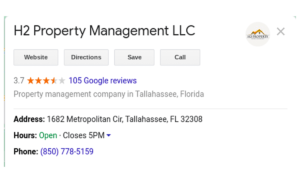8 Marketing Metrics Property Managers Should Track
With access to so much data in today’s world, it can be difficult to know which marketing metrics are the most critical to track, especially for property managers. If you’re ready for the list that will help you evaluate your growth, highlight success, and define areas for improvement, this list is for you. Find out what’s working, what needs improvement, and what you can do to impact each metric.
1. Tenant acquisition costs
Definition: The total average cost spent to acquire a new tenant, including all spend for ads and other marketing tactics, salaries, and overhead.
How to calculate it: Take your annual expenditure on marketing (ads, salaries, overhead, etc.) and divide it by the number of tenants you brought in that year (or in the time frame you want to measure).
Example: In one year, a property management company spent $400,000 on ads, salaries, overhead, and other marketing tactics. They acquired 500 new tenants.
$400,000 / 500 = $800 per tenant
Why it matters: This number tells you how effective your marketing efforts are and how much you should set aside to reach your acquisition goals. If you’re overspending, evaluate your marketing strategies to see which costs are not bringing in new tenants.
How you can improve it: Establish a solid presence on the advertising platforms your potential tenants frequent (such as Google, social media, and property management review sites) before spending money there. Connect with tenants and make use of content marketing on free platforms first. This will greatly enhance paid advertising efforts on these platforms down the road.
2. Net Promoter Score
Definition: A metric (ranging from -100 to 100) used to predict business growth based on the experience of your current tenants.
How to calculate it: Begin by asking your current tenants how likely (on a scale of 1 – 10) they are to refer your property management company to a friend.
From there, group tenants into three categories:
- Promoters: score 9 – 10 and are likely to be loyal tenants who actively recruit others to your property.
- Passives: score 7 – 8 and can be persuaded toward you or a competitor.
- Detractors: score 0 – 6. These are tenants who had negative experiences with your property and are likely to dissuade others from renting from you.
Next, calculate the percentage of Promoters and Detractors from your total responses. Subtract the percentage of Promoters from the percentage of the Detractors to find your Net Promoter Score (NPS).
Example: 1,000 tenants participated in your most recent survey. 300 scored 9 – 10, 500 scored 7 – 8, and 200 scored 0 – 6.
Promoter percentage = 300 / 1,000 or 30%
Detractor percentage = 200 / 1,000 or 20%
20% – 30% = -10 NPS
Why it matters: It’s always good to have an idea of your tenant satisfaction rates. Now more than ever, reputation equals revenue. If your tenants are happy, you can leverage their reviews to acquire more tenants. If tenants aren’t satisfied, you can evaluate their experience and feedback to improve your tenant experience.
How you can improve it: Focus on each interaction you have with tenants. Where are the hold ups and what are the pain points? Create a modern experience with convenient services like texting for maintenance requests and mobile rent payments.
3. Lead sources
Definition: The original point of contact where a tenant first interacts with or hears about your property.
How to calculate it: Ask new tenants (in person, via text, or email) how they discovered your property. If you use a Customer Relationship Management (CRM) platform or tenant database, you can also track leads as they come in through referrals, social media, Google Business Profile, or other sources. Review your data to see what your top lead source is (and where you should invest more marketing spend).
Example: In 2019, your property management company acquired 200 new tenants. 130 originated from Google searches, 25 from word of mouth, 30 drove by the apartments you manage, and 15 clicked on your Facebook ad.
Why it matters: Generating leads requires strategic effort and planning. Knowing the channels that generate and convert the most leads will help you gauge your spend on marketing programs and ease up on efforts that aren’t bringing in tenants.
How you can improve it: Be where your tenants are—social media platforms, Google listings, apartment rental sites, texting channels, email, and more. The more opportunities your target audience has to connect with you on the platforms they prefer, the more you can attract future renters there.
4. Lead response times
Definition: The average amount of time it takes for you to respond to marketing leads.
How to calculate it: After considering your lead sources (including phone calls, texts, emails, social media messages, etc.), calculate the response times for each type of lead. Add up the total response times and divide it by the number of new leads in that time frame.
Example: In the past year, you typically responded to your Facebook messages within 4 hours, phone calls within 2 minutes, walk-ins within 1 minute, texts within an hour, web chat in 5 minutes, and emails in 2 days.

Why it matters: You’re likely not the only place future renters are checking out in their search for housing. Responding quickly can help you stand out from the competition and win tenants sooner.
How you can improve it: Congregate all leads and customer interactions in one place. You can respond faster and with more efficiency. And if you’re worried about the cost, let the numbers speak for themselves: 94% of local businesses who use a reputation management software say that the ROI makes up for the cost.
5. Webchat conversion rates
Definition: The percent of web chat leads who become tenants.
How to calculate it: Calculate the total number of web chat leads in a given time period and divide it by the number of web chat conversions in that time.
Example: In July, your brand had 3,000 web chat leads. 100 of those leads converted on web chat.
100 / 3,000 = 3% web chat conversion rate
Why it matters: Adding a web chat platform can significantly increase your number of inbound leads and online transactions. Because in-person interactions may be limited right now, this additional resource can make a big difference for your staff and future tenants. Reduced wait times and convenient communication channels bode well for conversion rates.
How you can improve it: First, consider using bots to automate responses for FAQs. Customers appreciate a quick response even if it’s just to acknowledge their question and let them know that a member of your staff will be with them shortly. With a platform like Podium Webchat, the conversation can transition to texting, a channel customers are familiar with and can come back to over time.
6. Google ratings
Definition: The number of reviews and the average star rating of your Google Business Profile.
Example: In this example, the number of reviews is 105 and the average star rating is 3.7.
Why it matters: The search for housing often begins online. Customers may search for “apartments near me” and click on the first few relevant links. Google ranks your business based on the frequency, quantity, and average star rating of your Google reviews. 97% of consumers consult online reviews before converting. Improve your reputation through Google Business Profile and you’ll increase your revenue.
How you can improve it: Ask for reviews via text. Along with the invitation, inform your tenants how Google reviews help your business. 76% of customers asked to leave a review will. In addition to asking for reviews, it’s important to respond to every review (negative and positive). This will demonstrate to tenants that you’re on top of communications and that you care about providing positive experiences.
7. Tenant turnover rate
Definition: The percentage of tenants who move out during a contract period.
How to calculate it: Track the number of tenants who move out in a year. Divide that by the total number of tenants in a year and multiply by 100.
Example: In 2020, you had 200 total tenants. 50 of those tenants moved out.
50 / 200 = 25% turnover rate
Why it matters: It’s easier and less expensive to retain current tenants than to acquire new ones. While a certain amount of turnover is expected, this metric can indicate how well your business is running and how satisfied your tenants are with your services. If your rates are higher than usual (or the industry average), you’ll want to discover why.
How you can improve it: Ask for feedback via text. Throughout a tenant’s contract and when they leave, send a survey to ask about their experience with your brand. Evaluate the common themes of feedback and make a plan to address each area for improvement, whether they’re related to rent, maintenance, or something else.
8. Average days-to-lease
Definition: The average number of days it takes to fill a vacancy on your property.
Example: One of your listings may sell within the day, while other vacancies last for weeks. This can be impacted by the time of year, advertising/acquisition methods, rent prices, and the housing market.
Why it matters: The move-out process, getting the property ready for the next tenant, and actually finding the next tenant can be expensive and time-consuming. You’re losing money every day there’s a vacancy.
How you can improve it: If your average days-to-lease is high or increasing, consider your advertising methods and make sure you’re targeting the right crowd. Additionally, do everything you can to make it easy for tenants to convert quickly online—offer virtual tours, electronic signing methods for the lease, and mobile payment methods via text.
Generate more reviews, manage leads, and collect payments from one central platform. Your marketing metrics will improve and your day-to-day operations will become much more manageable. See how Podium can help. Request a free demonstration today.
















